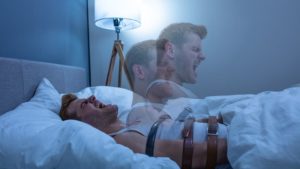Sleeping Paralysis is a strange and sometimes frightening experience that can occur when you fall asleep or wake up. Sleep paralysis occurs when your body is briefly unable to move or talk, even though your mind is awake. It is like being caught between sleep and consciousness.
People who have sleeping paralysis frequently report feeling stuck in position and can have intense hallucinations or sense a presence in the room with them. While sleep paralysis is not harmful, it can be upsetting and frightening for people who experience it.
We can look at it this way it causes huge mental disturbance and fear in a person. It is an unusual and horrible experience to go from.
Scientists believe Sleeping Paralysis happens when the brain and body are not in perfect harmony during the transition between sleep stages. However, Understanding what sleep paralysis is and why it occurs can help people feel less anxious if they encounter it.
It is important to understand Sleeping Paralysis occurs at specific stages of sleep, most notably the transition between awake and sleep, or between different stages of sleep, such as rapid eye movement (REM) sleep and non-rapid eye movement (NREM).
During REM sleep, your brain is busy but your muscles are temporarily paralyzed, preventing you from acting out your dreams and potentially injuring yourself. This Sleeping Paralysis is a natural protection mechanism that keeps you safe while sleeping.
Nonetheless, NREM sleep differs from waking or REM sleep in that it lacks fast eye movements and has lower levels of brain activity.
In other circumstances, however, this Sleeping Paralysis might last briefly when you wake up or go asleep, even if your mind is completely awake and aware. Sleep paralysis is caused by a brief connection between the brain and the body.
Moreover, several factors can cause sleep paralysis, such as;
Disordered sleep patterns: Sleeping Paralysis is more likely to occur when sleep rhythms are irregular or disturbed regularly.
Sleep disorders: some conditions include narcolepsy, obstructive sleep apnea, and insomnia, all of which increase the risk of Sleeping Paralysis.
Stress and anxiety: Emotional stress and worry can alter sleep patterns and raise the risk of having sleep paralysis.
Sleeping position: Sleeping on your back can occasionally cause sleep paralysis episodes, however, this varies from person to person.
Genetics: Sleep paralysis may have a hereditary component, as it runs in families.
What are sleeping paralysis symptoms?

The Symptom of Sleep paralysis can be various and distinct and can vary from person to person. The following are some common signs of sleep paralysis;
Inability to Move: One of the most distinguishing features of sleep paralysis is the temporary inability to move or speak, despite being mentally alert and aware. This paralysis often lasts a few seconds to many minutes.
The feeling of weight or Weight on Chest: During sleep paralysis, many people report feeling weight or heaviness on their chest, making breathing difficult.
Hallucinations: Sleep paralysis frequently results in intense hallucinations, which can be aural, visual, or physical. These hallucinations can include seeing dark figures or feeling a presence in the room, besides hearing voices or weird noises.
Panic, stress, or anxiety: Sleeping Paralysis is typically accompanied by strong feelings of anxiety, panic, or dread. These emotions can be overwhelming, adding to the discomfort of the situation.
Difficulty Breathing: During sleep paralysis, some people may feel like they are choking or having trouble breathing, which can exacerbate their anxiety and terror.
Rapid Heart Rate: During episodes of Sleeping Paralysis, the heart rate may rise, causing palpitations or a beating in the chest.
Sense of Being Watched or Threatened: During sleep paralysis, many people report feeling watched or threatened by an unseen presence, which can exacerbate their fear and anxiety.
What are the sleeping paralysis causes?

Physiological, psychological, and environmental variables can all contribute to sleep paralysis. Below are some common sleeping paralysis causes:
Irregular sleep patterns, such as regularly shifting sleep schedules or inconsistent sleep habits, can interrupt the natural sleep-wake cycle and raise the risk of sleep paralysis.
Sleep Disorders: Narcolepsy, obstructive sleep apnea, and insomnia are all related to an increased risk of sleep paralysis. These disorders can disturb sleep manner and increase the risk of having sleep paralysis.
Stress and worry: Emotional stress, worry, and other mental health concerns can all lead to sleep paralysis. Stressful life events, anxiety disorders, and other psychological issues might alter sleep patterns and raise the risk of Sleeping Paralysis episodes.
Sleeping Position: Sleeping on your back (supine position) has been associated with an increased risk of Sleeping Paralysis episodes. This position may increase the likelihood of having an episode by impairing respiratory function and raising the risk of sleep disruption.
Genetics: Sleep paralysis may have a genetic propensity, as it runs in families. Certain genetic variables may alter brain chemistry, sleep patterns, and other physiological processes that cause sleep paralysis.
Underlying Medical Conditions: Migraine, epilepsy, and psychiatric illnesses have been linked to an increased incidence of sleeping paralysis causes. These diseases may interfere with normal brain activity and increase vulnerability to sleep paralysis episodes.
Jet lag and shift work: Rapid shifts in time zones (jet lag) and irregular work patterns (shift work) can disturb the circadian rhythm, increasing the risk of Sleeping Paralysis.
Sleeping paralysis treatment

Treatment for sleep paralysis usually focuses on reducing contributory variables and increasing overall sleep quality. Here are a few techniques that might help:
Improve Sleep Hygiene: Sticking to a consistent sleep schedule, developing a soothing bedtime routine, and improving your sleep environment can all help you get better sleep and minimize your chances of experiencing Sleeping Paralysis.
Reduce tension and worry: Relaxation exercises, deep breathing, mindfulness meditation, and cognitive-behavioral therapy (CBT) can all help reduce worry and tension, which can lead to Sleeping Paralysis.
Adjust Your Sleeping Position: Changing your sleeping position, such as avoiding lying on your back (supine position), may assist some people lessen the frequency of sleep paralysis episodes.
Avoid Stimulants and Chemicals: Limiting or eliminating the use of chemicals that might disrupt sleep, such as caffeine, alcohol, and some medications, may assist improve sleep quality and lower the risk of Sleeping Paralysis.
Stimulus Control Therapy: Stimulus control therapy involves associating the bed and bedroom with sleep and relaxation by restricting bedtime activities to sleep and intimacy exclusively. This can assist enhance sleep quality and lower the risk of Sleeping Paralysis episodes.
Seek Help: Speaking with a healthcare expert, such as a doctor or therapist, can provide vital support and direction for treating sleep paralysis and any underlying concerns that contribute to the illness.
What Happens in the Brain and Body?
During sleep paralysis, the brain and body experience a momentary separation between wakefulness and sleep. Here is a quick overview of what happens in the brain and body during Sleeping Paralysis.
During Sleeping Paralysis, the brain remains active, similar to the condition of awake or REM sleep. This increased brain activity is responsible for vivid hallucinations and the sense of being awake.
During normal REM sleep, muscle paralysis occurs to prevent the body from acting out dreams and to ensure sleep safety. However, during sleep paralysis, muscle paralysis continues even when the brain is awake. As a result, even when cognizant, people are unable to move or talk.
The mix of awake with REM-like brain activity during sleep paralysis can result in intense hallucinations that can be visual, aural, or tactile. These hallucinations can include seeing dark figures, sensing a presence in the area, or hearing unusual noises.
Sensory perception remains intact during sleeping paralysis, allowing individuals to see, hear, and feel their surroundings. This can enhance the reality of hallucinations experienced during sleep paralysis.
Sleeping paralysis can cause physiological responses such as rapid heartbeat, short breathing, and emotions of fear or anxiety. These reactions are frequently the outcome of the acute fear and anxiety associated with the event.
The Ending Notes
To cut a long story short, sleep paralysis is an uncomfortable occurrence in which the brain and body experience a temporary dissociation between alertness and sleep. Individuals remain mentally aware during these periods while experiencing muscle paralysis, which is frequently accompanied by vivid hallucinations.
Most importantly, seeking expert advice and applying techniques to enhance sleep quality and reduce stress can help manage and reduce the frequency of sleeping paralysis episodes.
More research into the fundamental mechanisms of sleeping paralysis can help us better understand sleep disorders and brain function.













